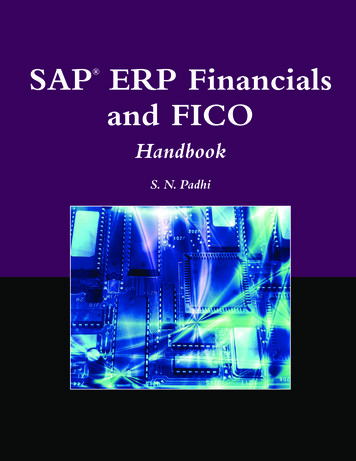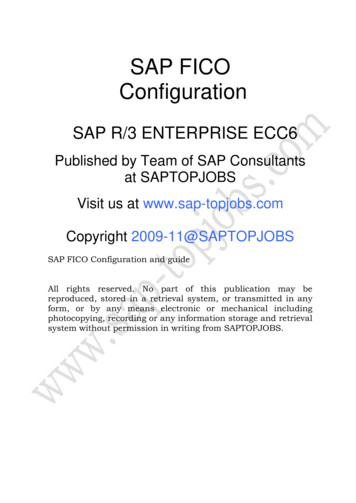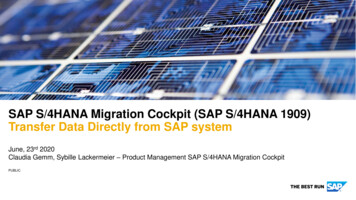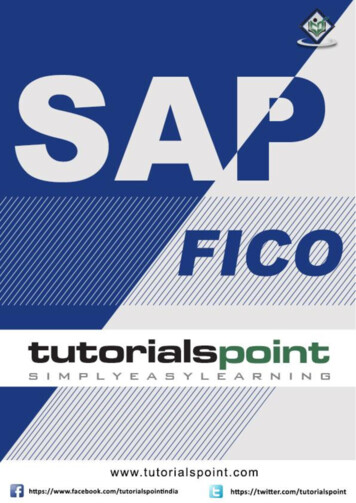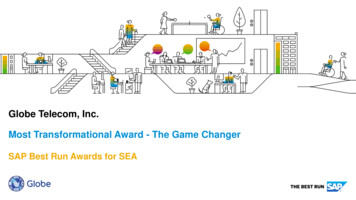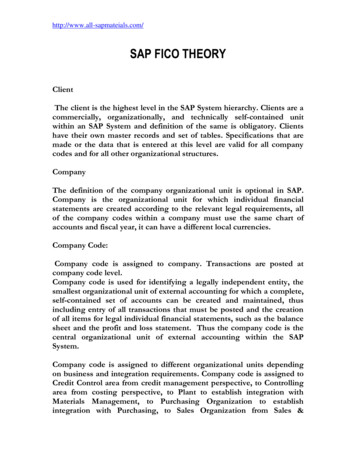
Transcription
http://www.all-sapmateials.com/SAP FICO THEORYClientThe client is the highest level in the SAP System hierarchy. Clients are acommercially, organizationally, and technically self-contained unitwithin an SAP System and definition of the same is obligatory. Clientshave their own master records and set of tables. Specifications that aremade or the data that is entered at this level are valid for all companycodes and for all other organizational structures.CompanyThe definition of the company organizational unit is optional in SAP.Company is the organizational unit for which individual financialstatements are created according to the relevant legal requirements, allof the company codes within a company must use the same chart ofaccounts and fiscal year, it can have a different local currencies.Company Code:Company code is assigned to company. Transactions are posted atcompany code level.Company code is used for identifying a legally independent entity, thesmallest organizational unit of external accounting for which a complete,self-contained set of accounts can be created and maintained, thusincluding entry of all transactions that must be posted and the creationof all items for legal individual financial statements, such as the balancesheet and the profit and loss statement. Thus the company code is thecentral organizational unit of external accounting within the SAPSystem.Company code is assigned to different organizational units dependingon business and integration requirements. Company code is assigned toCredit Control area from credit management perspective, to Controllingarea from costing perspective, to Plant to establish integration withMaterials Management, to Purchasing Organization to establishintegration with Purchasing, to Sales Organization from Sales &
http://www.all-sapmateials.com/Distribution perspective. Assignment of Company code to differentorganizational units thus helps to establish integration link betweendifferent modules in SAP.Credit Control AreaCredit control area is an organizational unit that represents the areawhere customer credit is awarded and monitored.Credit control area will be defined at company code level, sales area level(sales organization, distribution channel and division), in customer’smaster record.Credit limits can normally be specified in the individual customer masterrecords at sales organization level. The credit limits at the control arealevel are checked during sales order processing.Company code is assigned to credit control area.Chart of DepreciationChart of depreciation is country-specific and is defined independentlyorganizational units. Charts of depreciation are used in order to managevarious legal requirements for the depreciation and valuation of assets.Typically the depreciation values for the asset to be calculated indifferent ways based on business needs, both internal and external. Thechart of depreciation, therefore, is a directory of depreciation areasorganized according to business management requirements.Depreciation keys will be designed for calculating automaticdepreciation of the assets in each depreciation area.In order to make a company code usable in Asset Accounting, you haveto assign a chart of depreciation to the company code.Assignment to Plant / Location – Plant / Location do not have anyAsset accounting significance. However, they could be used forreporting purposes.
http://www.all-sapmateials.com/Chart of AccountsChart of accounts is a classification scheme used for accounting andwith the purpose to provide a framework for recording values or valueflows in order to guarantee an orderly representation of accounts. Foreach G/L account, the chart of accounts contains the information thatcontrols how an account functions and how a G/L account is created ina company code.The chart of accounts is shared by Financial Accounting as well asControlling.Account groups that are assigned to the G/L master records, determinethe number range and data relevant for the master records.Fiscal Year VariantFiscal year is generally a period of 12 months for which a companyregularly creates financial statements. Fiscal Year April to Marchassigned to company code for posting the accounting transactions inthat particular company code.A fiscal year starts from 1st April and ends on 31st March of every year isdivided into 12 posting periods for which a start and a finish dates havebeen defined for posting of documents in company code.Based on the posting date in the accounting transaction, system willderive the posting period. In addition to the regular posting periods,defined up to four special periods for year-end closing.Currencies & Exchange RatesCurrencies are legal mode of processing and reporting businesstransactions in legal company code. Each currency dealt by company isdefined in SAPIn Financial Accounting, for the company code, INR (Indian Rupee) isconfigured as local currency in which currency ledgers should bemanaged. Local currency (or company code currency) is typically thenational currency of country in which company code is situated. From acompany code view, all other currencies are then foreign currencies. Theaccount currency can be defined in the GL Master.In order to for the system to translate amounts into various currencies,exchange rates need to be maintained. daily or periodic basis. \For each currency pair, different exchange rates can be defined and thenit’s possible to differentiate between them by using exchange rate types.
http://www.all-sapmateials.com/Exchange rates for different purpose for the same date are defined in thesystem as exchange rate types. The company only needs to specify thetranslation rate between each currency and the base currency.Variant for Open Posting PeriodA separate variant for posting period is defined for every company code.You can specify for each variant which posting periods are open forpostings. Two intervals are available for doing this. For every intervalenter a lower period limit, an upper period limit and the fiscal year. Youclose periods by selecting the period specifications so that the periods tobe closed are no longer contained.Define Tolerance Groups for employeesEmployees are classified in to tolerance groups basing on, the maximumdocument amount the employees is authorized to post, the maximumamount the employee can enter as a line item in a customer or vendoraccount, the maximum cash discount percentage the employees cangrant in a line item, and the maximum acceptable tolerance for paymentdifferences for the employee.Determine Tolerance Groups – Customers & VendorsTolerance groups are created for postings of differences in payment andresidual item, which can occur during payment settlement. Definedtolerance groups are assigned to each customer and vendor via thecustomer and vendor master record.Document TypesPostings to various accounts are made through documents. Onlycomplete documents can be posted in SAP. Document types are createdto differentiate different types of transactions depending on businessneed and number range can be assigned each document type. You canfurther specify the characteristics for the document types based onbusiness use. Posting keys are used to post transactions to accounts. The
http://www.all-sapmateials.com/combination of positing key and document type can restrict the type ofaccounts to be posted for the transaction.When customer or vendor account is posted, the system automaticallymakes a posting to the corresponding reconciliation account in thegeneral ledger. As a result amount totals from sub-ledger accounting nolonger needs to be transferred to the general ledger before preparation ofbalance sheet.Certain line items like gain/losses from exchange rate differences, pricevariance etc. are generated automatically by the system.Special G/L transactions can be used to account special transactions inaccount receivable or payable and are displayed separately in generalledger and the sub-ledger. Transactions like bill of exchange, downpayments, bank guarantee etc. can be accounted through special G/Ltransaction option.Create General Ledger MasterGeneral Ledger Master is created at Chart of Accounts Level and also atCompany Code Level. At Chart of Accounts Level, it consists of the GLaccount number, Profit and Loss Account or Balance Sheet Account,description. At Company Code level, it consists of data pertaining toaccount currency, only balances in local currency, tax category,reconciliation account for account type, open item management, lineitem display, field status, post automatic and relevant to cash flow etc.Create Vendor MasterVendor master is created centrally in materials management & financialaccounting with their respective views. However, financial vendors canbe created only in financial accounting. For example, employees,auditors, insurance companies etc. When it is created centrally, it haspurchasing view and also accounting views. In cases, where it is definedin financial accounting, the accounting views only are defined.In case of central creation, materials management personnel will createthe purchasing view of the vendor and financial accounting personnelwill create the accounting views for the same. The accounting viewconsists of reconciliation account, method of payment, tolerance groupsetc.
http://www.all-sapmateials.com/It is necessary that the reconciliation account for the Vendor is correctlyidentified and defined in the master data.Create Customer MasterCustomer Master is created centrally in sales and distribution andfinancial accounting with their respective views. However, they arecreated only in financial accounting as in the case of customers for saleof assets, sale of scrap etc. When customer master is created centrally, ithas sales view and also accounting views. In cases, where it is defined infinancial accounting, only the accounting views are defined.In case of separate creation, sales and distribution personnel will createthe sales organization view of the customer and financial accountingpersonnel will create the accounting views for the same. The accountingview consists of reconciliation account, method of payment, tolerancegroups etc.It is necessary that the reconciliation account for the customer iscorrectly identified and defined in the master data.Create Asset MasterAssets are created under respective asset classes. When an asset iscreated under an asset class, the default values pertaining to that classlike, depreciation area, depreciation key useful life etc., are copied. Assetvalues are managed for different needs, both internal and external. SAPenables management of values in parallel in as many depreciation areasas needed without having to maintain multiple asset masters for thispurpose. The various purposes for which asset values are to bemaintained and the depreciation calculation methods and parametersneed to be clearly laid down.The depreciation terms, if required can be changed. Low Value Assets(LVA) can be handled as a separate Asset Class as they are fullydepreciated in the month of purchase. The maximum value for low valueassets has to be decided and can be specific to the depreciation areamaintained under chart of depreciation. Also decision needs to be takenwhether low value assets should be managed collectively or individually.In case of collective management, the entire acquisition and productioncosts of the asset, divided by the total quantity, are checked against the
http://www.all-sapmateials.com/LVA maximum amount defined in configuration under individualdepreciation area.Assets need to be assigned to cost centers so that the depreciation costsof these assets get properly charged to cost centers. Since it’s alsoproposed to use Profit center accounting, assets can be categorizedunder profit center through cost center assignments.The general and time dependent data fields like description of assetquantity, cost center which asset related plant and location where it issituated to be filled in the data.Create Cost CenterCost centers are areas of responsibility where costs are incurred andmonitored. Care has to be taken before creating a cost center as towhether it is really necessary to create the cost center and whether therequired costs can be captured there. If costs can not be captured, thenobviously the creation of a cost center becomes redundant.Before creating a cost center, it is necessary that a hierarchy is createdlogically defining the cost center groups, keeping in view the reportingrequirements. The node under which the cost center is to be created is tobe decided before creating the cost center.Create Profit CenterA profit center is an organizational unit in accounting that reflects amanagement-oriented structure of the organization for the purpose ofinternal control. You can analyze operating results for profit centersusing the period accounting approachBefore creating a profit center, it is necessary that a hierarchy is createdlogically defining the profit center groups, keeping in view the reportingrequirements. The node under which the profit center is to be created isto be decided before creating the profit center.Create Internal OrderInternal Orders are temporary cost objects, where costs are stored andsettled later to other cost objects like cost centers or internal orders etc.
http://www.all-sapmateials.com/There are various types of internal orders like overhead orders, capitalinvestment orders etc.; it is necessary that before creating an order, thetype of order needs to be known.Internal Orders can be statistical or real.In case of statistical orders, the costs are simply captured and no furtherallocations can be made from them. A box is to be checked, if the orderis to be created as statistical order. The statistical order is used forcapturing of expenses item wise like telephone and vehicles and others.In case of real orders, further allocations can be done. In case
SAP FICO THEORY Client The client is the highest level in the SAP System hierarchy. Clients are a commercially, organizationally, and technically self-contained unit within an SAP System and definition of the same is obligatory. Clients have their own master records and set of tables. Specifications that are


